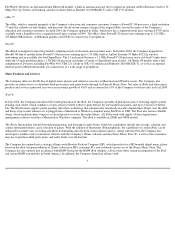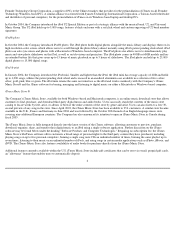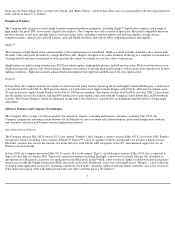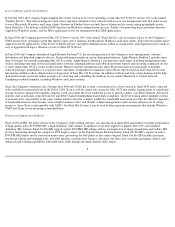Apple 2004 Annual Report Download - page 17
Download and view the complete annual report
Please find page 17 of the 2004 Apple annual report below. You can navigate through the pages in the report by either clicking on the pages listed below, or by using the keyword search tool below to find specific information within the annual report.
feature, and performance competition. Over the past several years, price competition in the market for personal computers has been particularly
intense. The Company's competitors who sell personal computers based on other operating systems have aggressively cut prices and lowered
their product margins to gain or maintain market share. The Company's results of operations and financial condition have been, and in the future
may continue to be, adversely affected by these and other industry-wide downward pressures on gross margins.
The principal competitive factors in the market for personal computers include relative price/performance, product quality and reliability, design
innovation, availability of software, product features, marketing and distribution capability, service and support, availability of hardware
peripherals, and corporate reputation. Further, as the personal computer industry and its customers place more reliance on the Internet, an
increasing number of Internet devices that are smaller, simpler, and less expensive than traditional personal computers may compete for market
share with the Company's existing products.
The Company is currently taking and will continue to take steps to respond to the competitive pressures being placed on its personal computer
sales as a result of innovations in competing platforms. The Company's future operating results and financial condition are substantially
dependent on its ability to continue to develop improvements to the Macintosh platform in order to maintain perceived functional and design
advantages over competing platforms.
The Company's initial success with the development of an end-to-end music offering, which includes the iTunes software, iTunes Music Store
and iPod digital music player, has already encouraged significant competition in this area from other companies, many of whom have greater
financial, marketing, and manufacturing resources than those of the Company. The Company anticipates that competition will intensify requiring
the Company to respond as hardware, software and content providers work more collaboratively to offer integrated products that compete
against the Company's offerings. The Company believes it maintains a competitive advantage by more effectively integrating the entire end-to-
end music solution, including the hardware (iPod), software (iTunes) and distribution of third-party music content (iTunes Music Store).
Raw Materials
Although most components essential to the Company's business are generally available from multiple sources, certain key components
(including microprocessors and application-specific integrated circuits ("ASICs")) are currently obtained by the Company from single or limited
sources. Some other key components, while currently available to the Company from multiple sources, are at times subject to industry wide
availability constraints and pricing pressures. In addition, the Company uses some components that are not common to the rest of the personal
computer and consumer electronics industries, and new products introduced by the Company often initially utilize custom components obtained
from only one source until the Company has evaluated whether there is a need for, and subsequently qualifies, additional suppliers. If the supply
of a key or single-sourced component to the Company were to be delayed or curtailed or in the event a key manufacturing vendor delays
shipments of completed products to the Company, the Company's ability to ship related products in desired quantities and in a timely manner
could be adversely affected. The Company did experience such delays during fiscal 2004, which resulted in the constrained availability of
certain products. The Company's business and financial performance could also be adversely affected depending on the time required to obtain
sufficient quantities from the original source, or to identify and obtain sufficient quantities from an alternative source. Continued availability of
these components may be affected if producers were to decide to concentrate on the production of common components instead of components
customized to meet the Company's requirements. The Company attempts to mitigate these potential risks by working closely with these and
other key suppliers on product introduction plans, strategic inventories, coordinated product introductions, and internal and external
manufacturing schedules and levels. Consistent with industry practice, the Company acquires components through a combination of formal
purchase orders, supplier
14
























